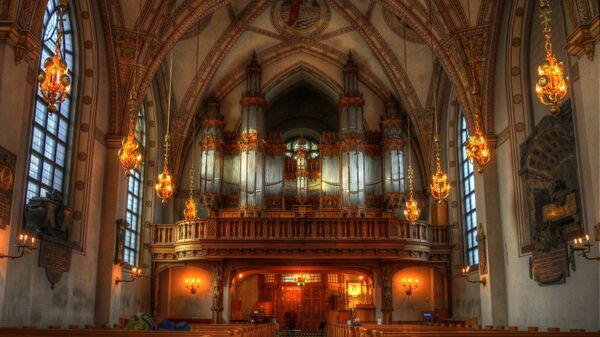On 1 December, on the first day of Advent, St. Paul's Church in Malmö became the first in Sweden to receive an LGBT-themed altarpiece.
The new altarpiece, the homoerotic painting “Paradise” by Elisabeth Ohlson Wallin, is roughly based on Reformation-era painter Lucas Cranach's “Adam and Eve”, and features features black and white gays and lesbians in sexual poses.
The Church of Sweden, which allowed gay marriage in 2009, and has since been a vocal ally of the LGBT movement, didn't hide its joy.
“On Sunday, history is written. Sweden's only LGBT altarpiece (Elisabeth Ohlsson Wallin) is received by St. Paul's church in Malmö. Of course, it hangs in the choir, next to the 'old' altarpiece. We are so happy and proud!”, Helena Myrstener, the pastor of St. Paul's Church, tweeted.
På söndag skrivs historia. Sveriges enda hbtq-altartavla (Elisabeth Ohlsson Wallin) tas emot i S:t Pauli kyrka i M-ö. Självklart hänger den i koret, bredvid den ”gamla” altartavlan. Vi är så glada o stolta! pic.twitter.com/W5TBkL8osa
— helena myrstener 📎 (@helenamyrstener) 27 ноября 2019 г.
The Church of Sweden in Malmö suggested the altarpiece was a token of the church's inclusivity and representation.
“It is with pride and joy that we receive 'Paradise' in the St. Paul Church. We need images that open up for greater inclusion and identification in the Church. We are grateful to Elizabeth's artistry that allows us to build a credible church that shows there is a place in Paradise for all of us, regardless of who we love and how identify ourselves” the Swedish Church in Malmö wrote in a press release.
“Before this board came up here, only men were represented in the artwork. But with this board all of us are”, priest Sofia Tunebro told national broadcaster SVT. She also suggested that it held a “very positive view of sexuality”. She also contended that it included “phallic symbols” and suggested that the Serpent was a “transsexual woman”.
Elisabeth Ohlson Wallin, who is openly lesbian, is known for her support of the LGBT cause. In 1998, her exhibition Ecce Homo in Uppsala Cathedral stirred up a commotion for placing Jesus among homosexuals and transvestites, even riding a bicycle in a gay pride parade.
The reception on social media was a rather mixed one, however. While some found it quite up-to-date and responded with elated messages and added rainbows, others saw the new altar as a bearer of sinister news.
“Not impressed. This is not about Christian values, but only political activism. Shameful!”, one user wrote.
Inte imponerad. Detta handlar inte om kristna värderingar utan enbart politisk aktivism. Skamligt!!
— Petronius (@Snapphanare) 1 декабря 2019 г.
“The Church of Sweden: We do not understand why so many members choose to leave each year, what can we do differently to stop the negative trend? Also the Church of Sweden: the Serpent is a transsexual woman”, another one scoffed.
Svenska Kyrkan: Vi förstår inte varför så många medlemmar väljer att lämna oss varje år, vad kan vi gör annorlunda för att stoppa den negativa trenden?
— Alexander Еdbом 🇸🇪🇷🇺👁️ (@alexanderedbom) 1 декабря 2019 г.
Också Svenska Kyrkan: pic.twitter.com/4xl6d0FTFj
Others questioned whether church officials had read the Bible at all, citing the story of Sodom and Gomorrah. Another common theme was to allude to Leviticus 18:22, a passage that openly forbids same-sex relations. Still others, holding the most pessimistic views, suggested that religion was dead.
Leviticus 18:22 You shall not lie with a male as with a woman; it is an abomination.
— sowoox (@sowoox) 1 декабря 2019 г.
The Church of Sweden is known for its liberal position on issues such as homosexuality, mass immigration, and climate change. At over 5 million members, it is Sweden's largest religious organisation and Europe's largest Lutheran denomination. However, its membership has been rapidly declining in recent decades (at a pace of 2 percent annually). As of 2018, 57 percent of the Swedish population were members of the Swedish Church, a marked drop from 95 percent in 1972 in a matter of only a few decades.




